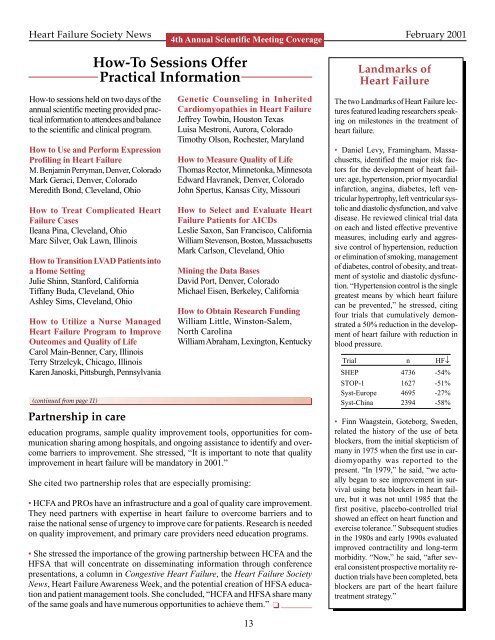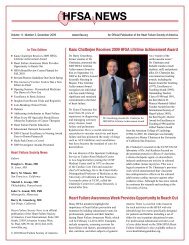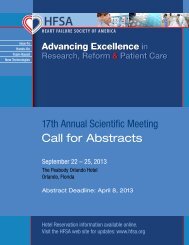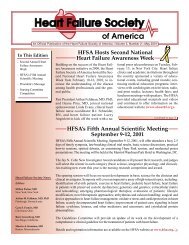Volume 3, Number 1 - Heart Failure Society of America
Volume 3, Number 1 - Heart Failure Society of America
Volume 3, Number 1 - Heart Failure Society of America
Create successful ePaper yourself
Turn your PDF publications into a flip-book with our unique Google optimized e-Paper software.
<strong>Heart</strong> <strong>Failure</strong> <strong>Society</strong> News February 2001<br />
4th Annual Scientific Meeting Coverage<br />
(continued from page 11)<br />
Partnership in care<br />
How-To Sessions Offer<br />
Practical Information<br />
How-to sessions held on two days <strong>of</strong> the<br />
annual scientific meeting provided practical<br />
information to attendees and balance<br />
to the scientific and clinical program.<br />
How to Use and Perform Expression<br />
Pr<strong>of</strong>iling in <strong>Heart</strong> <strong>Failure</strong><br />
M. Benjamin Perryman, Denver, Colorado<br />
Mark Geraci, Denver, Colorado<br />
Meredith Bond, Cleveland, Ohio<br />
How to Treat Complicated <strong>Heart</strong><br />
<strong>Failure</strong> Cases<br />
Ileana Pina, Cleveland, Ohio<br />
Marc Silver, Oak Lawn, Illinois<br />
How to Transition LVAD Patients into<br />
a Home Setting<br />
Julie Shinn, Stanford, California<br />
Tiffany Buda, Cleveland, Ohio<br />
Ashley Sims, Cleveland, Ohio<br />
How to Utilize a Nurse Managed<br />
<strong>Heart</strong> <strong>Failure</strong> Program to Improve<br />
Outcomes and Quality <strong>of</strong> Life<br />
Carol Main-Benner, Cary, Illinois<br />
Terry Strzelcyk, Chicago, Illinois<br />
Karen Janoski, Pittsburgh, Pennsylvania<br />
Genetic Counseling in Inherited<br />
Cardiomyopathies in <strong>Heart</strong> <strong>Failure</strong><br />
Jeffrey Towbin, Houston Texas<br />
Luisa Mestroni, Aurora, Colorado<br />
Timothy Olson, Rochester, Maryland<br />
How to Measure Quality <strong>of</strong> Life<br />
Thomas Rector, Minnetonka, Minnesota<br />
Edward Havranek, Denver, Colorado<br />
John Spertus, Kansas City, Missouri<br />
How to Select and Evaluate <strong>Heart</strong><br />
<strong>Failure</strong> Patients for AICDs<br />
Leslie Saxon, San Francisco, California<br />
William Stevenson, Boston, Massachusetts<br />
Mark Carlson, Cleveland, Ohio<br />
Mining the Data Bases<br />
David Port, Denver, Colorado<br />
Michael Eisen, Berkeley, California<br />
How to Obtain Research Funding<br />
William Little, Winston-Salem,<br />
North Carolina<br />
William Abraham, Lexington, Kentucky<br />
education programs, sample quality improvement tools, opportunities for communication<br />
sharing among hospitals, and ongoing assistance to identify and overcome<br />
barriers to improvement. She stressed, “It is important to note that quality<br />
improvement in heart failure will be mandatory in 2001.”<br />
She cited two partnership roles that are especially promising:<br />
• HCFA and PROs have an infrastructure and a goal <strong>of</strong> quality care improvement.<br />
They need partners with expertise in heart failure to overcome barriers and to<br />
raise the national sense <strong>of</strong> urgency to improve care for patients. Research is needed<br />
on quality improvement, and primary care providers need education programs.<br />
• She stressed the importance <strong>of</strong> the growing partnership between HCFA and the<br />
HFSA that will concentrate on disseminating information through conference<br />
presentations, a column in Congestive <strong>Heart</strong> <strong>Failure</strong>, the <strong>Heart</strong> <strong>Failure</strong> <strong>Society</strong><br />
News, <strong>Heart</strong> <strong>Failure</strong> Awareness Week, and the potential creation <strong>of</strong> HFSA education<br />
and patient management tools. She concluded, “HCFA and HFSA share many<br />
<strong>of</strong> the same goals and have numerous opportunities to achieve them.” ❏ _______<br />
Landmarks <strong>of</strong><br />
<strong>Heart</strong> <strong>Failure</strong><br />
The two Landmarks <strong>of</strong> <strong>Heart</strong> <strong>Failure</strong> lectures<br />
featured leading researchers speaking<br />
on milestones in the treatment <strong>of</strong><br />
heart failure.<br />
• Daniel Levy, Framingham, Massachusetts,<br />
identified the major risk factors<br />
for the development <strong>of</strong> heart failure:<br />
age, hypertension, prior myocardial<br />
infarction, angina, diabetes, left ventricular<br />
hypertrophy, left ventricular systolic<br />
and diastolic dysfunction, and valve<br />
disease. He reviewed clinical trial data<br />
on each and listed effective preventive<br />
measures, including early and aggressive<br />
control <strong>of</strong> hypertension, reduction<br />
or elimination <strong>of</strong> smoking, management<br />
<strong>of</strong> diabetes, control <strong>of</strong> obesity, and treatment<br />
<strong>of</strong> systolic and diastolic dysfunction.<br />
“Hypertension control is the single<br />
greatest means by which heart failure<br />
can be prevented,” he stressed, citing<br />
four trials that cumulatively demonstrated<br />
a 50% reduction in the development<br />
<strong>of</strong> heart failure with reduction in<br />
blood pressure.<br />
Trial n HF↓<br />
SHEP 4736 -54%<br />
STOP-1 1627 -51%<br />
Syst-Europe 4695 -27%<br />
Syst-China 2394 -58%<br />
• Finn Waagstein, Goteborg, Sweden,<br />
related the history <strong>of</strong> the use <strong>of</strong> beta<br />
blockers, from the initial skepticism <strong>of</strong><br />
many in 1975 when the first use in cardiomyopathy<br />
was reported to the<br />
present. “In 1979,” he said, “we actually<br />
began to see improvement in survival<br />
using beta blockers in heart failure,<br />
but it was not until 1985 that the<br />
first positive, placebo-controlled trial<br />
showed an effect on heart function and<br />
exercise tolerance.” Subsequent studies<br />
in the 1980s and early 1990s evaluated<br />
improved contractility and long-term<br />
morbidity. “Now,” he said, “after several<br />
consistent prospective mortality reduction<br />
trials have been completed, beta<br />
blockers are part <strong>of</strong> the heart failure<br />
treatment strategy.”<br />
13
















